 | wnc business & community directory |
|
This is an archived page that may contain outdated or incorrect information. Please visit www.Asheville.com for the latest news, events, and more.
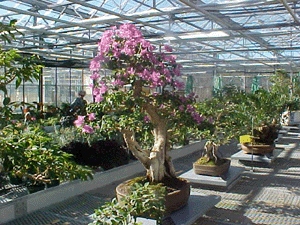 For both the regular visitor and the uninitiated, the splendor of the North Carolina Arboretum begins with the entry road into this massive and picturesque facility. Owned and operated by the University of North Carolina system on 426 acres in the Bent Creek Experimental Forest, the road winds gently past woodlands, trails, high stone retaining walls, and some glorious landscaping. As visitors get closer to the Visitor Education Center and the landscaping becomes more obviously "designed" with gardens full of beautiful plantings (all of which are easily identified with markers notating the plant names), the thought is bound to arise � where do all of these magnificent plants come from? The answer is found in the Arboretum's state-of-the-art greenhouse complex, located a short drive away from the Arboretum's Visitor Education Center and massive public gardens.
For both the regular visitor and the uninitiated, the splendor of the North Carolina Arboretum begins with the entry road into this massive and picturesque facility. Owned and operated by the University of North Carolina system on 426 acres in the Bent Creek Experimental Forest, the road winds gently past woodlands, trails, high stone retaining walls, and some glorious landscaping. As visitors get closer to the Visitor Education Center and the landscaping becomes more obviously "designed" with gardens full of beautiful plantings (all of which are easily identified with markers notating the plant names), the thought is bound to arise � where do all of these magnificent plants come from? The answer is found in the Arboretum's state-of-the-art greenhouse complex, located a short drive away from the Arboretum's Visitor Education Center and massive public gardens. A visit to the greenhouse production facility at the NC Arboretum offers a fascinating look at a high-level horticulture operation. Sporting an expansive 7,200-square-feet of greenhouse space, the complex features several distinct areas, each designed for a specific purpose.
Double doors in the rear of the headhouse lead to Greenhouse 1. Greenhouse 1 houses annual plants, tropical plants for interior displays, and tropical members of the Arboretum's celebrated bonsai collection. The atmosphere in this greenhouse is the warm, humid environment that most people expect to find in a greenhouse. Heat is provided by natural sunlight as well as hot water flowing through pipes embedded in the floor and walls. Each of the greenhouses has many conservation-oriented features, including the heating and cooling system in this building. Housed in a series of small boxes throughout the greenhouse, a computerized system of climate controls constantly monitors temperature and humidity levels. If the temperature rises above an accepted level, top vents automatically open and several large fans turn on to pull warm air out of the houses. To both cool and humidify air, this greenhouse is equipped with an ingenious "evaporative cooling pad system" along the south wall. Large corrugated cardboard panels (see third photo on right) are designed to allow water to trickle down the length of the pads. Fans at the opposite end of the greenhouse pull air through a vent behind the system; the air is cooled and humidified as it crosses the damp cardboard.
To the rear of Greenhouse 2 lies the nursery area, a fenced location that, for a plant, is almost but not quite, like being on its own in the great outdoors. The strong fencing protects plants from damage by deer and rodents and special "hoop houses" (see photo below) protect bonsai and other plants from direct sunlight. Greenhouse visitors might want to pay special attention to the Arboretum's phenomenal bonsai collection (see top photo). Started in 1992, this bonsai collection is among the finest in the country, and very much worth a visit.
The greenhouse complex is open to the public Monday - Friday from 8am to 4pm, except Wednesdays when it closes at 2pm; it is closed on weekends (except on rare occasions). It is free to all Arboretum visitors; usual parking fees apply.
For more information about the NC Arboretum, please call 828-665-2492 or visit their web site at www.ncarboretum.org.
|

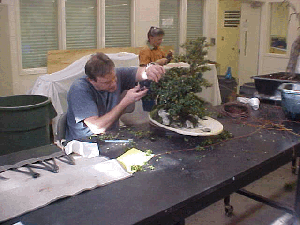 Volunteers and staff occupy the headhouse (see second photo on right), an area designed with proper workspace to transplant, propagate, and train plants. The headhouse is the first stop on a tour of the greenhouse, and is located directly behind the small reception area. During most hours of the day, volunteers and staff can be found carefully shaping plants from the bonsai collection, repotting plants, or gently handling tiny seedlings that will one day be on display in the gardens. The headhouse features a large pot washing station that allows the Arboretum to re-use potting materials without transferring diseases to new plants. This is also the area where classes, such as basic horticulture or bonsai, are taught.
Volunteers and staff occupy the headhouse (see second photo on right), an area designed with proper workspace to transplant, propagate, and train plants. The headhouse is the first stop on a tour of the greenhouse, and is located directly behind the small reception area. During most hours of the day, volunteers and staff can be found carefully shaping plants from the bonsai collection, repotting plants, or gently handling tiny seedlings that will one day be on display in the gardens. The headhouse features a large pot washing station that allows the Arboretum to re-use potting materials without transferring diseases to new plants. This is also the area where classes, such as basic horticulture or bonsai, are taught. 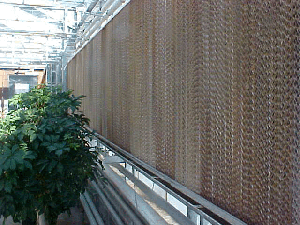 Greenhouse 2 is a "cool house," where the temperature and environment are close to those out found outdoors. This greenhouse features a "spaghetti" watering system - something that any backyard gardener would envy - that provides controlled irrigation to hundreds of plants at the same time. The weighted end of a tube is placed in each pot or basket; each tube then connects to a large system of pipes. When the water is turned on, the system delivers the same amount of water to each pot.
Greenhouse 2 is a "cool house," where the temperature and environment are close to those out found outdoors. This greenhouse features a "spaghetti" watering system - something that any backyard gardener would envy - that provides controlled irrigation to hundreds of plants at the same time. The weighted end of a tube is placed in each pot or basket; each tube then connects to a large system of pipes. When the water is turned on, the system delivers the same amount of water to each pot.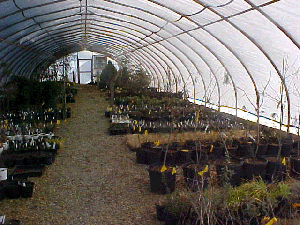 Visitors should note that none of the plants in the greenhouse complex are for sale; they are used solely in the operation of the North Carolina Arboretum. The greenhouse produces plants for seasonal landscape exhibits at the Arboretum, including the Quilt Garden, the Entry Plaza, and the Grand Garden Promenade. But the plants contained within the greenhouses, as well as this wonderful state-of-the-art complex itself, are the stuff of gardeners' dreams.
Visitors should note that none of the plants in the greenhouse complex are for sale; they are used solely in the operation of the North Carolina Arboretum. The greenhouse produces plants for seasonal landscape exhibits at the Arboretum, including the Quilt Garden, the Entry Plaza, and the Grand Garden Promenade. But the plants contained within the greenhouses, as well as this wonderful state-of-the-art complex itself, are the stuff of gardeners' dreams.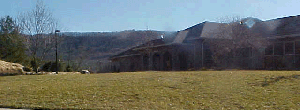 The Arboretum (see bottom photo) is located next to the Blue Ridge Parkway entrance ramp at Milepost 393, two miles south of Exit 2 (Highway 191/Brevard Road) off I-26. Arboretum grounds are open seven days a week except December 24-26 and January 1. Property hours are 8 AM - 9 PM, April through October, and 8 AM - 7 PM, November through March. The Visitor Education Center is open Monday through Saturday from 9 AM to 5 PM, and on Sundays from noon to 5 PM. Parking fees are $6 per personal motor vehicle, $25 for commercial vans and $45 for tour buses. Parking is free for all visitors all day Tuesday.
The Arboretum (see bottom photo) is located next to the Blue Ridge Parkway entrance ramp at Milepost 393, two miles south of Exit 2 (Highway 191/Brevard Road) off I-26. Arboretum grounds are open seven days a week except December 24-26 and January 1. Property hours are 8 AM - 9 PM, April through October, and 8 AM - 7 PM, November through March. The Visitor Education Center is open Monday through Saturday from 9 AM to 5 PM, and on Sundays from noon to 5 PM. Parking fees are $6 per personal motor vehicle, $25 for commercial vans and $45 for tour buses. Parking is free for all visitors all day Tuesday.